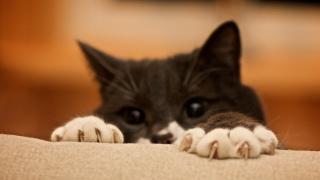Destructive Cats – Solving Scratching & Chewing Problems

Most cats, especially young kittens, have a strong, natural desire to play and explore. But this desire can lead to major problems when your cat claws sofa or destroys your houseplants. The best way to prevent destructive scratching is by providing an environment that meets your cat’s needs.
Exploration and play
The first consideration is to provide a safe, stimulating environment. Cat-proof your home and build a play center where your cat can climb, perch, and scratch. Provide a few toys your cat can bat around, such as spring-mounted, dangling, or bouncy toys. Some cats enjoy climbing into empty cardboard boxes or cat carriers, especially if food treats have been left in-side. Ping-Pong balls and walnuts make inexpensive toys that many cats love. Cats may even find some dog chew toys appealing. Avoid tempting your kitten into by teasing it with your fingers—you may end up with a play-biting cat.
Indoor cats with little access to grass or other vegetable matter may chew houseplants. Offer them lettuce, catnip, or a kitty herb garden in exchange. Some cats are more likely to suck or chew on material such as rugs or clothing. You can correct the problem by keeping these objects away from your cat, providing alternative chew toys, or changing its diet to dry, bulky food.
Preventing Problems
To keep your cat away from problem areas, first try child locks, barricades, or closed doors. For persistent problems or areas that cannot be barricaded, use remote punishment, taste and odor aversion, or booby traps as deterrents. Never use physical punishment it may cause to fear you and to avoid the problem area only when you are around. If you can remain out of sight and use remote punishment, your cat should learn without fearing you. Use a water gun or loud noise to stop the behavior. Destructive chewing can be discouraged by using commercial anti-chew sprays, mentholated products, vinegar, or a little cayenne pepper mixed with water. Other options include aversive odors (perfume, deodorant soap, citrus oil) or booby traps (motion activated alarms or a stack of plastic cups set to topple when the cat enters the area or scratches). You shouldn’t punish your cat unless you have provided an alternate scratching area for it and have rewarded it for scratching there.
Scratching
Scratching is a normal behavior that allows your cat to condition its claws and mark its territory. It also provides a nice stretch. Of course, when your cat’s scratching is on furniture or your favorite stereo speakers, it quickly becomes intolerable.
To prevent destructive scratching, keep your cat away from tempting areas, trim its nails regularly, and provide a proper scratching post. Encourage your cat to use a scratching post by placing one near its favorite sleeping area and perhaps a second post in a prominent area. It is important to select surface textures that are both practical and appealing to the cat—carpet, sisal, a nubby fabric_ or even bare wood. Attract your cat to the scratching post by attaching a few toys, rubbing a little catnip into the surface, or providing a more elaborate structure with climbing and perching areas. Give your cat a food reward whenever it approaches its post, and multiple rewards whenever it actually scratches the post. If you prefer to build your own scratching post, ensure that the peril is tall enough for your cat to scratch with its legs fully extended and is sturdy enough to support your cat’s weight without toppling. You can leave the wood bare or cover it with a suitable surface covering. You can construct an inexpensive scratching post by securely attaching a fireplace log to a plywood base.
Persistent Problems
If your cat continues to scratch in an inappropriate area, put a post there. Food rewards will keep your cat interested in the post away from your furniture. If destructive scratching persists, cover the scratched are with plastic, a loosely draped piece of material, or short strips of double sided tape. Another option is to use plastic covering that fit over your cat’s nails. These are available from your veterinarian.
Declawing is not a routine or necessary part of preventative health care for kittens. Trimming nails, which is quick and easy, is a regular part of caring for indoor cats as well as providing scratching surfaces (please see the article The Importance of Cat Claws for more information). Many people are surprised to learn that removal of the claws requires removal of bone at the last joint and is actually a partial toe amputation, equivalent to removal of a finger at the last knuckle. There are well-studied adverse effects from this procedure such as chronic pain, arthritis, nerve pain, tendency to bite and urinating outside the litter box. At three months of age this is the perfect time to start teaching your kitten how you prefer him to use, or not use, his claws.
Info courtesy of the Pet Behavior Brochure Series from the AAHA Press.- Behavior (15)
- Caring for your pet (292)
- cat (16)
- Community Events (20)
- dog (17)
- From Our Clients (15)
- Happy Tails (12)
- News (454)
- Press (53)
- Products (2)
- Questions (4)
- Recalls (1)
- Special Offers (6)
- Tips & Advice (231)
- Uncategorized (21)
- Veterinary Services (49)
